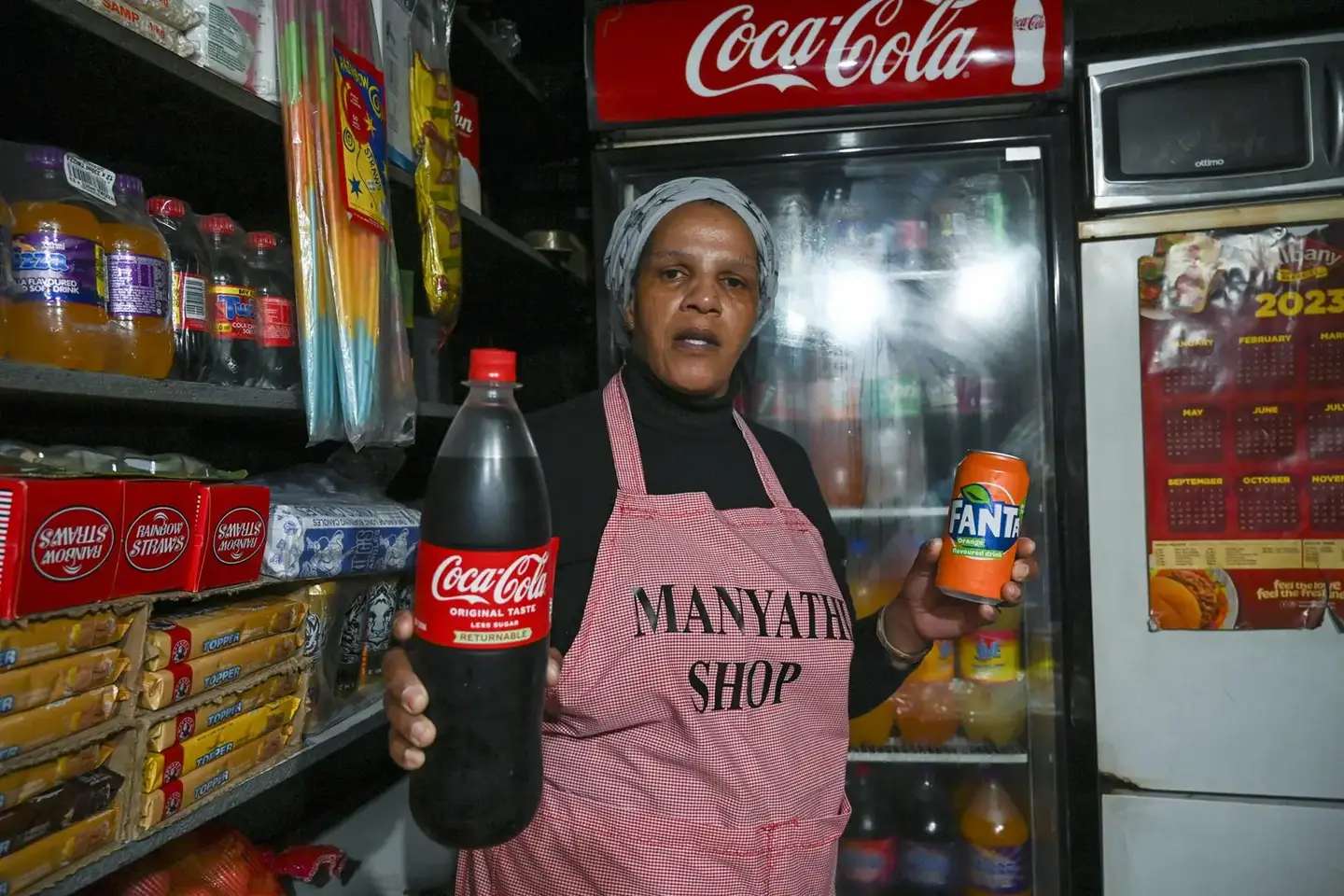Global study links diabetes and heart disease cases to sugary drinks
A new global study, published in the journal, Nature Medicine, sheds light on sugary beverages’ impact, revealing a clear link to type 2 diabetes (T2D) and cardiovascular diseases (CVD).

Woman holds Coca-Cola products in her small store in a shipping container in Nyanga East, Cape Town, South Africa.(CREDIT: David Harrison)
Sugar-sweetened beverages (SSBs) are a ubiquitous part of diets worldwide, yet their toll on public health is staggering. These drinks—soft drinks, energy drinks, fruit punches, and other sugary beverages—carry significant health risks.
A new global study, published in the journal, Nature Medicine, sheds light on their impact, revealing a clear link to type 2 diabetes (T2D) and cardiovascular diseases (CVD).
SSBs are consumed in massive quantities globally. In 2020, the average adult drank 2.6 servings (248 grams) per week. Consumption varies widely by region. South Asia has the lowest intake at 0.7 servings per week, while Latin America and the Caribbean lead with 7.3 servings.
Among the 30 most populous countries, Colombia tops the list with an average of 17.4 servings per week, compared to India, China, and Bangladesh at just 0.2 servings.
Men generally consume more SSBs than women, and younger adults outpace older generations. Education levels also play a role: higher education correlates with higher intake in regions like Latin America and sub-Saharan Africa. In contrast, more educated individuals in the Middle East and North Africa tend to consume fewer sugary beverages.
Urbanization also influences consumption patterns. Urban populations in sub-Saharan Africa and South Asia tend to consume more sugary drinks compared to their rural counterparts. This trend is reversed in the Middle East and North Africa, where rural areas report higher consumption. These disparities highlight the complex interplay between education, geography, and lifestyle choices in determining SSB intake.
The health consequences of SSBs are alarming. These beverages are rapidly digested, leading to spikes in blood sugar levels. Regular consumption contributes to weight gain, insulin resistance, and metabolic dysfunction, all of which increase the risk of T2D and CVD.
In 2020, 2.2 million new cases of T2D and 1.2 million new cases of CVD were directly linked to SSB consumption. This accounts for 9.8% of global T2D cases and 3.1% of CVD cases. The burden is particularly pronounced in Latin America, the Caribbean, and sub-Saharan Africa, where SSBs are responsible for 24% of new T2D cases and over 10% of new CVD cases.
The human cost extends beyond diagnosis. SSBs contributed to 12.5 million disability-adjusted life years (DALYs) globally in 2020, including 5 million from T2D and 7.6 million from CVD.
Additionally, these drinks caused 80,278 deaths from T2D and 257,962 deaths from CVD. Colombia, Mexico, and South Africa bear a disproportionate share of this burden. In Colombia alone, 48% of new T2D cases are linked to sugary drinks.
Related Stories
Beyond these immediate health impacts, the economic burden of treating T2D and CVD linked to SSBs is substantial. Developing nations, often already constrained by limited healthcare resources, face additional strain in addressing the long-term consequences of these diseases. This underscores the urgent need for preventive strategies and health policies aimed at reducing SSB consumption.
SSBs’ adverse effects are well-documented. The liquid form of these beverages leads to rapid consumption and digestion, resulting in lower satiety and increased caloric intake. High glucose levels activate insulin and other regulatory pathways, promoting fat storage and insulin resistance.
Fructose, another common sweetener, directly contributes to liver fat production and metabolic dysfunction. Over time, these processes increase the risk of hypertension, dyslipidemia, and atherosclerosis, culminating in CVD and T2D.
SSBs also displace healthier dietary options, exacerbating their impact. Combined, these factors create a cascade of health risks that disproportionately affect men, younger adults, and urban populations. Countries with rising incomes face unique challenges as sugary drinks become more accessible and desirable.
The effects of sugary drinks extend to metabolic pathways in the liver and muscle tissues. High fructose levels, for instance, accelerate hepatic fat synthesis, leading to ectopic fat deposits that impair organ function.
Insulin resistance—a hallmark of T2D—is further exacerbated by these metabolic changes, creating a cycle of increasing vulnerability. These insights underline the complex biological mechanisms through which SSBs contribute to chronic diseases.
Experts emphasize the urgent need for interventions. “Sugar-sweetened beverages are heavily marketed and sold in low- and middle-income nations,” says Dariush Mozaffarian, a senior researcher on the study. “Not only are these communities consuming harmful products, but they are also often less well-equipped to deal with the long-term health consequences.”
Some nations have taken steps to mitigate the damage. Mexico, for instance, implemented a tax on sugary beverages in 2014. Early evidence shows a decline in consumption, particularly among low-income groups. However, much more needs to be done. “As a species, we need to address sugar-sweetened beverage consumption,” adds Mozaffarian.
Researchers advocate for a multi-pronged approach. Public health campaigns, stricter advertising regulations, and expanded taxation on sugary drinks are key measures. These interventions must be tailored to the most affected regions, such as Latin America and Africa, where the health consequences are severe.
“We need urgent, evidence-based interventions to curb consumption of sugar-sweetened beverages globally,” says Laura Lara-Castor, another author of the study. Without swift action, the global burden of T2D and CVD will continue to rise, shortening lives and straining healthcare systems.
Educational initiatives are crucial in reshaping consumer behavior. Awareness campaigns targeting youth and urban populations can help reduce SSB consumption by highlighting the health risks. Schools, workplaces, and community centers can play pivotal roles in disseminating this information.
Additionally, the promotion of healthier alternatives, such as water and unsweetened beverages, can provide viable substitutes for sugary drinks.
Governments must also address the marketing tactics employed by beverage companies. Restricting advertisements aimed at children and limiting promotional campaigns in low-income regions can help curb demand. Policies that mandate clear nutritional labeling on beverage packaging can further empower consumers to make informed choices.
The introduction of sugar taxes in several countries has shown promise. Beyond Mexico, nations like the United Kingdom and South Africa have implemented similar measures with encouraging results. Revenue generated from these taxes can be reinvested into public health programs, creating a cycle of improvement.
The global crisis of SSB consumption demands immediate attention. By addressing this silent epidemic, governments and public health organizations can improve lives and reduce healthcare costs. The stakes are high, but with targeted policies and community support, a healthier future is within reach.
Collaboration between policymakers, health professionals, and communities will be key to mitigating the far-reaching effects of sugary beverages.
The findings of this study offer a roadmap for action. Comprehensive strategies that combine education, regulation, and taxation can create meaningful change.
The fight against SSB-related diseases is a fight for public health, economic stability, and a better quality of life for millions worldwide. The time to act is now.
Note: Materials provided above by The Brighter Side of News. Content may be edited for style and length.
Like these kind of feel good stories? Get The Brighter Side of News' newsletter.
Joshua Shavit
Science & Technology Writer | AI and Robotics Reporter
Joshua Shavit is a Los Angeles-based science and technology writer with a passion for exploring the breakthroughs shaping the future. As a contributor to The Brighter Side of News, he focuses on positive and transformative advancements in AI, technology, physics, engineering, robotics and space science. Joshua is currently working towards a Bachelor of Science in Business Administration at the University of California, Berkeley. He combines his academic background with a talent for storytelling, making complex scientific discoveries engaging and accessible. His work highlights the innovators behind the ideas, bringing readers closer to the people driving progress.



